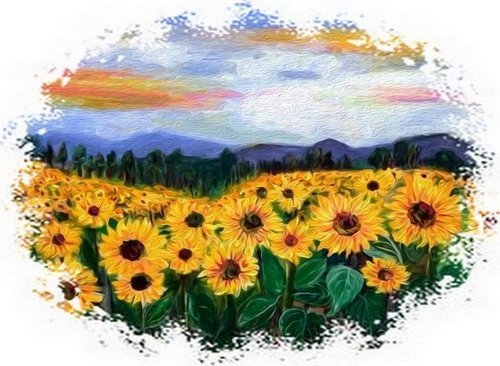Visit to the exhibition hall of historical artifacts from Japan itself
Today I decided to surprise you a little with entertaining and interesting exhibits from our new exhibition complex, which was opened not so long ago in Krasnodar Park.
The full name of this new complex sounds like: The Exhibition Hall of National Cultural and Historical Artifacts. And the museum itself is located in the Old Kominka Folk House.

The ancient Japanese Kominka House is a wooden structure for meeting important guests, made in the traditional Japanese minka style. This architectural style originated in the Kinsei era of the Edo period (from 1603 to 1867).
Previously, the Japanese had a spacious living room in such a house, where they received dear guests. To make it especially pleasant for the guest, a picturesque scroll corresponding to the season was hung in the niche of the room, an ikebana flower arrangement was placed, incense sticks were lit and refined samples of traditional ceramic products were demonstrated.
Now there is only one small hall in Kominka, and there are not so many exhibits themselves, but they promise to constantly replenish the collection!
What can you see here?
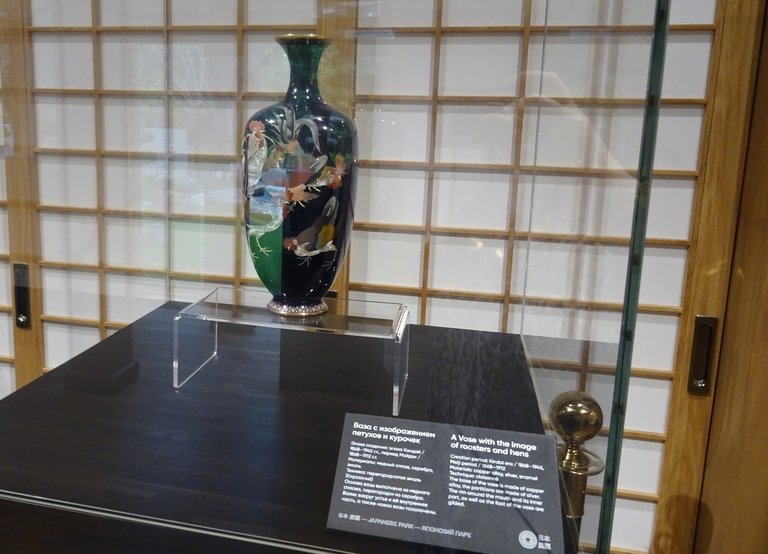
Of course, various authentic ceramic vases, paintings made of the thinnest plates of mother-of-pearl, kimonos, objects of cultural heritage and everyday life: antique swords, utensils, knives, figurines and other various exhibits of traditional Japanese culture.
This vase with the image of roosters and chickens is made of copper alloy and silver. However, as you can see, the leg of the vase is gilded. It's a very original work up close.
The hall itself is decorated in a restrained Japanese style, minimalistic and light inside.
For comfortable contemplation, small groups are allowed inside, so that no more than 8-10 people are in the room.

And this is a bivo - Japanese variety of lute, a traditional instrument of Ben Ten, the patron goddess of literature, music, wealth and femininity.
The strings of such a lute are made of the finest silk threads glued with rice glue. The material from which the lute is made is mulberry, chestnut and ivory.
There was even a copper brazier with a kettle and a tripod. Where else would you be able to see such objects from the past?

It is called a hibachi with the image of animals of the 12-year cycle. Copper and bronze were used in its manufacture. The word hibachi itself literally translates as "fire bowl".
And below is the real okimono
The okimono (translated as "the delivered thing") is already an independent work, devoid of any utilitarianism, albeit in modest size, but amazing in its filigree execution. Most often they were made of ivory, wood or precious metals, the light material was tinted with tea, mother-of-pearl, coral and various enamels could be used for decoration. It is okimono that many Japanese may still have in a specially designated place for them, which is called tokonoma.

This sculptural composition is represented by two storylines: a mother with children and chickens with chicks. Both lines are closely linked to each other by the philosophy of motherhood.
The work is delicate and very neatly done. Beautiful carving, lots of different details...
Although I liked these 7 gods of happiness the most.

The Seven Gods of Happiness when viewed from left to right: The Bisu is the one with the fish in his hands. Behind him stands Daikohu with a magic hammer and white rats of wealth;
This hammer was not simple at all. The magic Hammer of luck is an essential attribute of one of the seven deities of happiness, Daikohu.
It was believed that with a single touch, he could create anything his owner desired. And a mouse or rat is a companion of Daikohu and symbolizes well-being and wealth.
next comes the goddess Benten herself with a biwa (you have already seen the biwa above :-).
The fourth is Bisyamonten with a jumonji (Japanese spear). 5 - Fukurokuju with a scroll of wisdom, a crane and a turtle - symbols of longevity;
6 - Durodzin with a deer;
7 - Hotei with a fan and a canvas bag.

The legend associated with folklore is also interesting. According to it, these 7 gods of happiness travel every new year on the magic ship Takarabune, transporting their treasures. They come down from heaven and visit people, giving gifts to those who have done their best to live a good life.
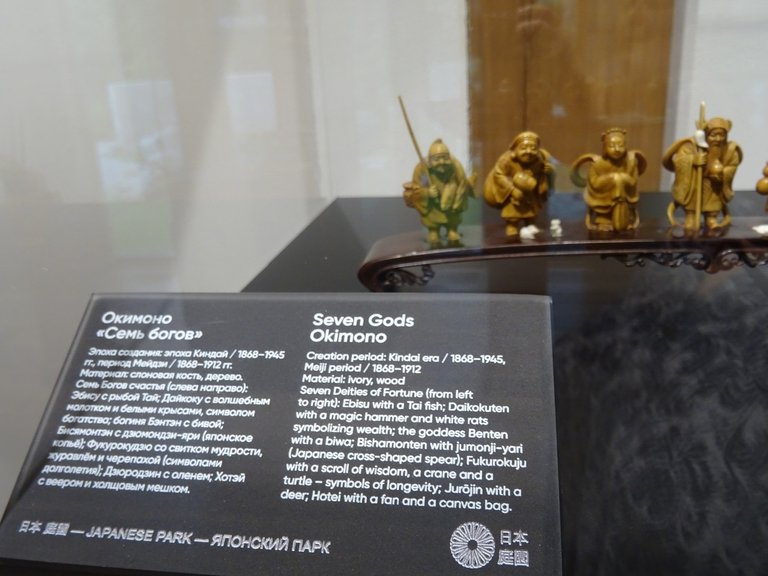
And this is the goddess Kannon herself with a dragon on a lotus. Bone carving.

Isn't it good?

Now in front of you is such a paired panel "Onna - Bugeysia" (ivory, mother of pearl).

The plaque below says that the panel depicts 2 Onna - Bugeisha women who were Japanese warriors, samurai.
One of them is dressed in samurai armor with a combat fan in her hand and a bow behind her back, but the second appears before us with a quiver of arrows behind her back and a naginata (a curved Japanese sword in her hands).

But such images of birds are known to emphasize the beauty of nature. Items decorated in the shibayama style are a special phenomenon in Japan.
Most of these products were produced in Tokyo and Yokohama and were oriented towards European taste, creating an impression of luxury and sophistication.

I must say that in Japan, the sun and the chrysanthemum symbolize the same hieroglyph. Until the 19th century, a similar chrysanthemum could only be depicted on imperial paraphernalia as a sign of power, dignity and honor.


There were not so few exhibits here, but they are all intended for lovers and admirers of Japanese culture. There was even this ark among them.
Okimono "Seven Gods of Happiness and a treasure ship".
Takarabune (literally "treasure ship") sailed to the land of the rising sun and brought on board Sitifukujin ("seven gods of happiness").
The ship has a nose in the form of the mythical bird of happiness Ho-oh, the holds are filled to the top with bags of rice and gold.
The tradition of giving this waterfowl cornucopia appeared in the XVII century. The set of deities present on the ship changed several times and finally took shape by the middle of the XVIII century.
On New Year's Eve, this souvenir is put under the pillow along with a Happiness Boat postcard and waiting for prophetic dreams. A dream of the sacred Mount Fuji, a divine sailboat, an eagle (messenger of the gods) and eggplants (symbol of fertility and masculine strength) promise a happy year. If the dream turned out to be out of hand, then a piece of paper with the image of a treasure ship is sent out of harm's way into a stream or river.
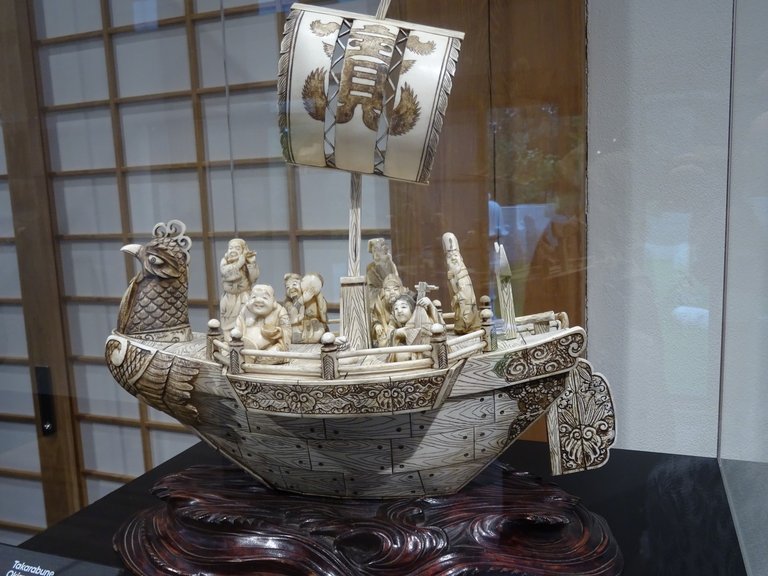
Agree that this is a pretty interesting sample

But this is just a container for storing tea. The so-called teapot of the Sotsum.

And finally, you have a real vintage Yaon ceremonial kimano in front of you.

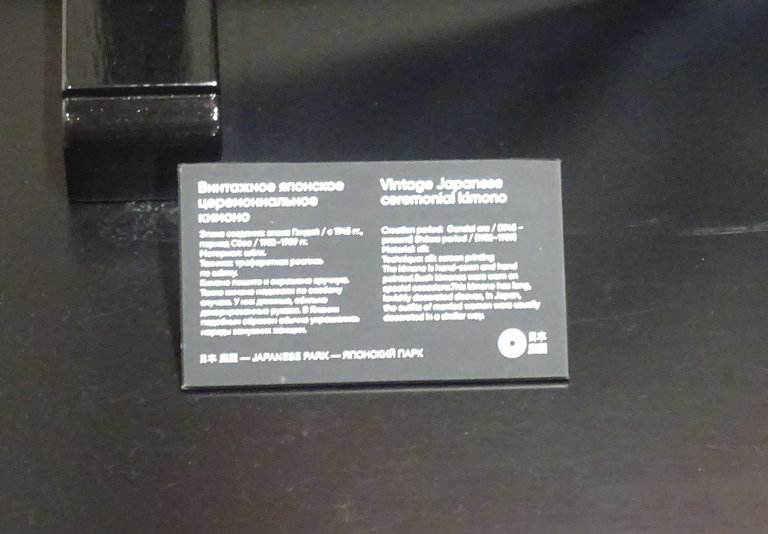
Of course, there were also a lot of paintings and various panels...

Some of them were made in a traditional style, while others were made of straw, bone, fish scales or other available materials.
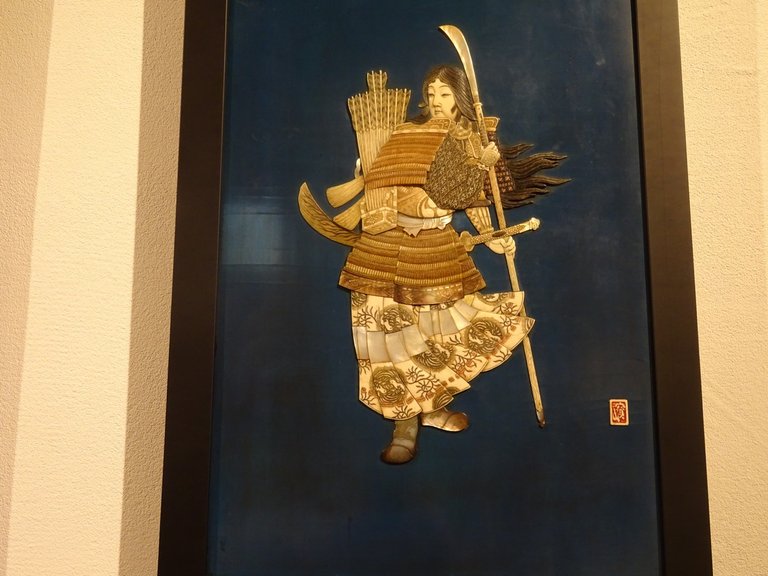

I also saw the Tanto sword, which was used on the battlefield as an auxiliary weapon, for finishing off the enemy, cutting off the head (a trophy from the samurai, proving their valor), sometimes for seppuku (hara-kiri).
And the helmet is kabuto, the half mask is Hambo, the steel breastplate is Dou, the bracers are Kote, once in Japan it was the spearmen who were at the forefront of major battles.
Yari (weapon) is a Japanese type of shaft weapon, which is a spear with many modifications.

It was very interesting to look at all these exhibits. You will learn a lot about Japan, its culture, way of life and customs of the people who inhabit it.
How do you like, for example, such a portable Buddhist ark "Zushi", in the form of a pagoda, designed to be placed on a home altar in a traditional Japanese house.

But at the end of this mini tour, a real Japanese warrior will appear to your attention.


I hope you enjoyed my photos and exhibits. And I was able to tell you some interesting and entertaining things about the culture and history of this distant land of the rising Sun.
I appreciate Your feedback and comments.
I wish you luck and have a nice day!
Best wishes!
